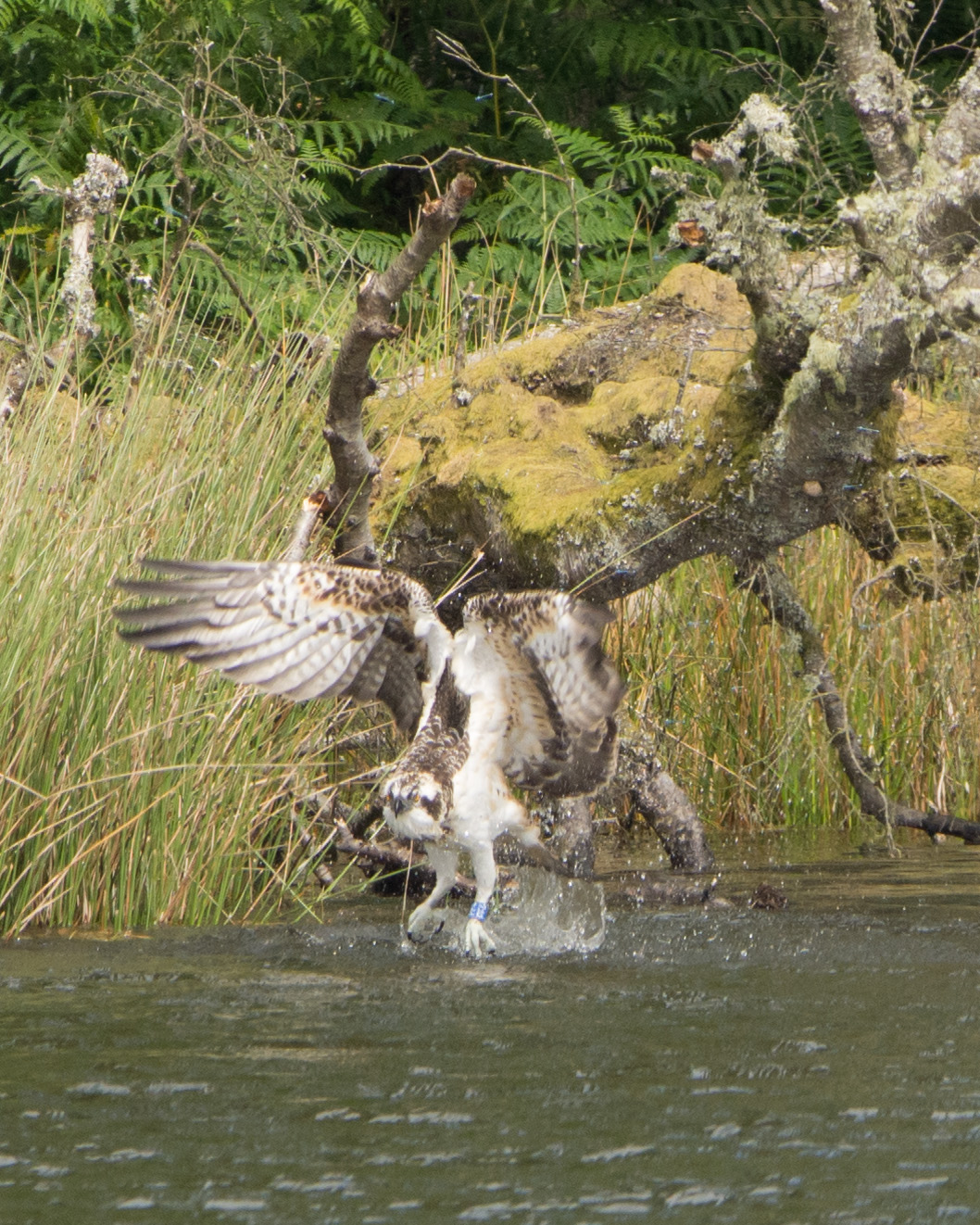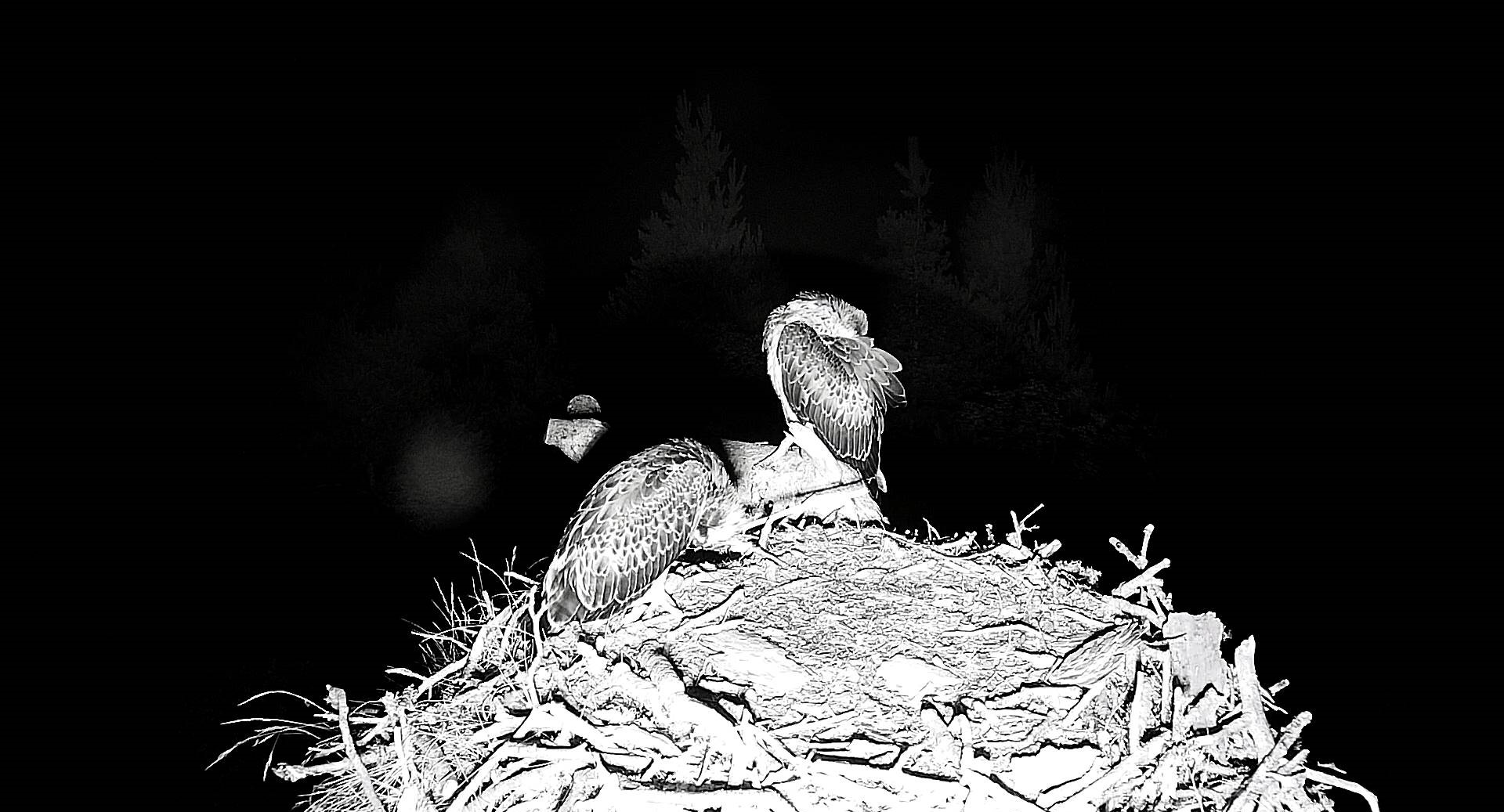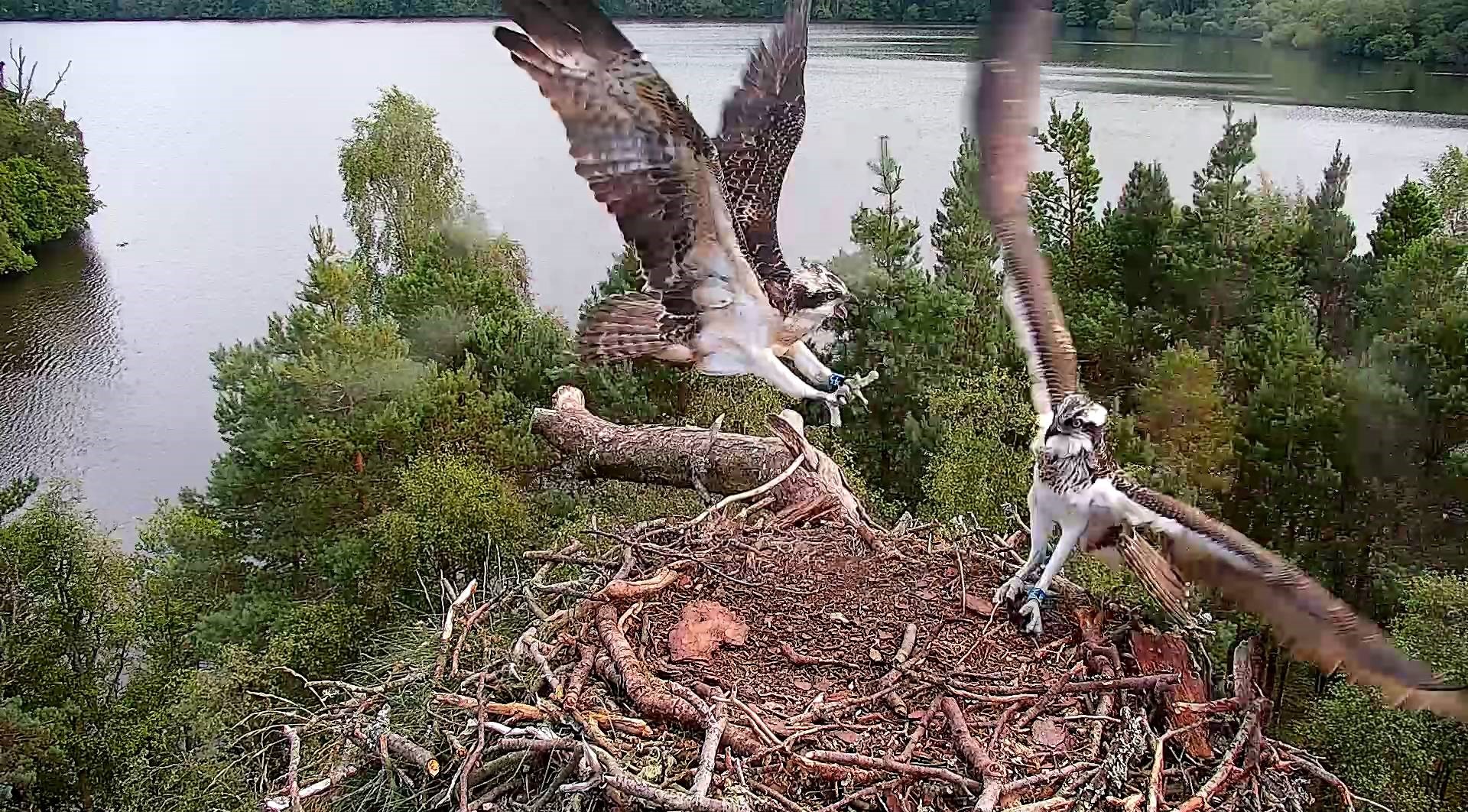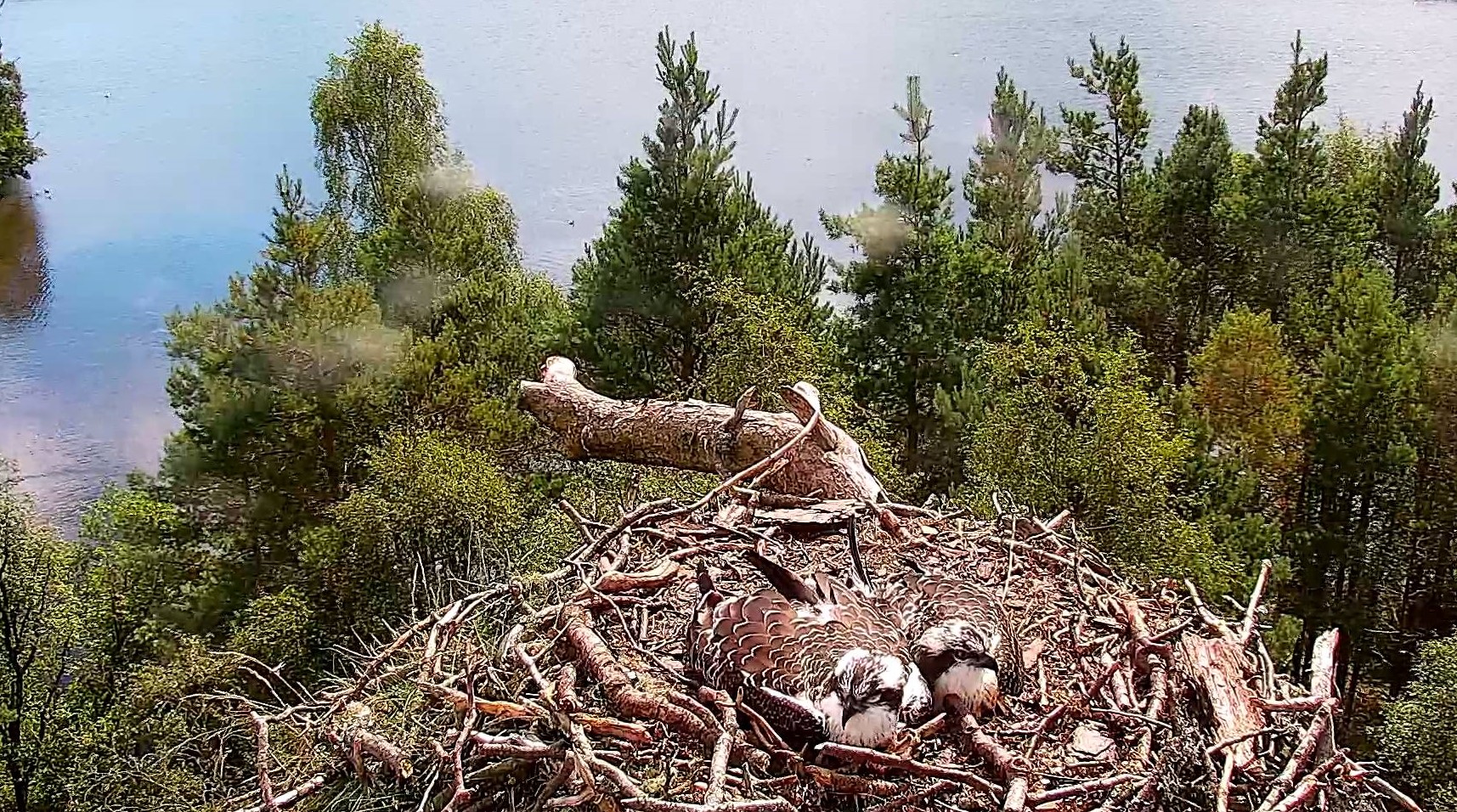Osprey Diary at Loch of the Lowes – Weeks 17 & 18
It’s been an exciting and tumultuous couple of weeks for the osprey family at Loch of the Lowes. Last time we shared a blog the young ospreys were testing their wings and building up their strength. It wasn’t long before the eldest chick, female ‘Blue PF4’ took to the skies on Sunday 9th at 10:07am, aged 57 days old.
Younger sibling, male ‘Blue PF5’ was not to be outdone and spent the next few days building up his confidence, strength and skill with some excellent hovering, or ‘helicoptering’ efforts!
He finally took to the skies aged 58 days, on Thursday 13th at 9:47am. After much flapping, jumping and squealing, the young lad made the leap from the perch into the sky. After a circuit of the Loch he landed with style into the centre of the nest, closely followed by his sister.
The osprey are certainly continuing to develop quickly, and with their new found freedom, there has been in a rise their competitive nature, especially when it comes to meal times! It’s incredible to think that just 9 weeks ago these feisty osprey were tiny wee ‘Bobbleheids’. Now they are out competing their Mum and ripping fish out of the talons of their Dad any time there is a delivery. Not to mention partaking in a healthy bit of sibling tug o’ war!
Generally speaking young osprey do not really learn to hunt for themselves until they leave on migration, however from time to time it is not uncommon for juveniles to have a ‘sploosh’ and attempt to fish for themselves.
Female PF4 is seen here sitting on her mother NC0’s favoured ‘Split Birch’ fishing perch, where she can drop down on unsuspecting jack pike and perch. It’s hard to tell whether she managed to catch something or picked up some vegetation in the water, but it bodes well for her development that she is all ready trying to perfect this essential skill.
She was captured on several occasions throughout the week having a ‘plop’ into the water and also washing her talons. This fabulous moment was captured by Steve White, a visitor to the hides on Monday 17th.

With increased independence, the roosting habits of the pair are now beginning to change too. At the start of the week the pair were sharing the nest at night, but this has already changed, with both preferring to find less exposed spots tucked away around the reserve.
The length of time the webcam will show an empty nest will increase until their migration, as the pair spend longer and longer periods away, exploring, building up a visual map and imprinting on the area – essential for their return in two years time as first time breeding adults.

Each season, not long after the chicks have fledged NC0 goes on a pre-migration hiatus, no doubt taking time to fuel up for the long journey ahead as she will leave several weeks ahead of the rest of the family. This usually lasts a few days, but for whatever reason this year she seems to have gone for a bit longer, as she was last seen in the evening of Sat 15th.
Perhaps with the quantity of fish in the area being erratic she has taken matters into her own talons and headed off further afield for a while. It’s also possible in this topsy-turvy year with strange weather patterns, that she might just have decided to head south, though this seems unlikely as it is still very early given her departure last season was on the 11th August. We will just have to wait and see how things unfold.
Of course whenever there are less fish coming into the nest, as will be the case with only LM12 hunting, any deliveries are fiercely fought for. Whilst this looks dramatic, it is a natural part of the young osprey asserting a pecking order. On this occasion PF4 emerged victorious, however PF5 was successful with an earlier delivery during this time.
One of the main roles NC0 plays is helping to defend the nest, in part by her mere presence, but also with her sheer bulk and superior defensive skills. LM12 will defend the area as best as he can and will attempt to gain the high ground and chase any guests out of the area. You will often hear his high pitched chipping alarm calls off the camera – indeed as I write this blog I can hear him seeing off a skydancing male intruder – however he also needs to ensure he does not get injured in any melees, so will often be more cautious in his defensive strategies.
With increased intruding pressure on the territory, even the youngsters have been getting involved. On Thursday a ringed female osprey from Wales or England (indicated by a colour ring on the right leg) landed on the nest perch – the youngsters were not amused! Whilst youngest osprey male PF5 shouted at the unwanted visitor, PF4 took the opportunity to snaffle down the snacklet delivered by LM12 a few minutes before. It wasn’t long before PF5 saw off the intruding osprey – marking a milestone in his development and ability to defend his territory!
We have also observed both youngsters bolting off the nest to chase herons who might have the audacity to fly nearby – interestingly they both emit an alarm call usually reserved for humans. We are not sure if this is because they are still learning how to communicate (their osprey alarm calls, begging calls and body language are still fairly similar and muddled), or whether NC0 also did this.
Certainly, with the increased interest in the area by other osprey on the look out for a prime nesting site for next season, it has been hard for LM12 to leave the area for extended periods to go hunting. This of course has meant that the youngsters, who are already on high alert from intruders are also ‘hangry’, and keen to assert themselves as the dominant sibling. The series of videos below shows them testing each other’s resolve, with youngster PF5 eventually getting the upper hand (or should that be wing) over his sister!
Over the last few days we have seen PF5 claim the nest for himself, frequently chasing his sister away – quite the turn around from the wee chick that would adopt submissive behaviour at meal times to avoid being battered! Unlike other other raptors such as golden eagles, osprey chicks do not tend to practice siblicide, but they will be assertive in ensuring the pecking order is known and adhered to.
Having been ousted from the nest, PF4 can now often be seen sitting on the split birch, and more recently has settled on a spot elsewhere in the reserve, close to where LM12 likes to preen, You can often hear her (and PF5) shouting for food from around the loch any time LM12 is in sight. There is every chance she is being fed away from the cameras, whilst PF5 appears to be getting his ‘take away’ brought to the nest, like last evening when he had a delivery of both supper and pudding!

There is no doubt that this season has been an odd one, starting with the very early arrival of both adults. We know that fishing has been tough in the wider area this year, with fish not running as well as usual in the rivers, and there seems to be less pike and perch in the local lochs – whether this is due to the very hot summer of last year and cold spring this season we don’t know.
Could the strange weather patterns or fluctuating fish levels encouraged NC0 to depart on an especially early migration, has she had an altercation with another osprey, or is she merely fueling up somewhere and therefore taking pressure off LM12? Again we don’t know. We will just have to wait and see – but rest assured if we have any sightings of her we will let you know!
What we do know is that wild animals are both adapted and capable of going for extended periods without much food. At the moment the youngsters are laying down huge fat reserves for their migration, so although they will scream and shout for food, they are more resilient than they appear. We also know that LM12 is an excellent fishermen, so if there are good fish to be caught, and he can leave the area for longer hunting trips, he is sure to deliver.
Meanwhile we will keep our fingers and talons crossed for some respite from intruders and for some larger fish deliveries to restore some calm to the nest!

Make sure you stay tuned to the live webcam to see how the family prepares for their migration journey in around a month’s time! You can also keep up to date with the daily lives of the ospreys by following us on Twitter or Facebook for regular updates.
‘Raz’ Rasmussen, Perthshire Ranger
The Trust’s Osprey Protection Programme at Loch of the Lowes is supported by players of People’s Postcode Lottery.
Help protect Scotland’s wildlife
Our work to save Scotland’s wildlife is made possible thanks to the generosity of our members and supporters.
Join today from just £3 a month to help protect the species you love.
Preface
It’s been an exciting and tumultuous couple of weeks for the osprey family at Loch of the Lowes. Last time we shared a blog the young ospreys were testing their …
